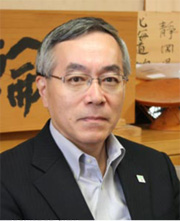Home > Highlighting JAPAN > Highlighting Japan OCTOBER 2011 > Preserving and Utilizing the Bounties of Forests
Highlighting JAPAN
INTERNATIONAL YEAR OF FORESTS
Preserving and Utilizing the Bounties of Forests
The United Nations has declared 2011 the International Year of Forests. The Japan Journal's Osamu Sawaji spoke with Forestry Agency Director General Yoshitsugu Minagawa about the current state of forests in Japan and around the world, and on the role that forests play.

Yoshitsugu Minagawa, director general of the Forestry Agency
Credit: THE JAPAN JOURNAL
Please explain the background to the United Nations declaring 2011 the International Year of Forests.
Yoshitsugu Minagawa: Between 1990 and 2010, the world's forests shrunk by more than 130 million hectares. Excessive logging is particularly serious in the forests of cold-weather zones such as Siberia and in tropical rainforests along the equator. This is why we see problems such as with the orangutan, which lives in the tropical rainforests of Indonesia, being threatened with extinction.
About two thirds of Japan's territory is covered in forests. However, in the artificial plantations that make up roughly 40% of Japan's forests, a slump in wood prices and lower demand for wood has led to little attention being given to maintenance such as tree thinning, and the disaster prevention functions and carbon dioxide (CO2) absorption capacity of these forests has declined as a result.
To remedy these circumstances, the International Year of Forests was declared with the aim of having as many people as possible understand the importance of sustainable forest management and utilization, or in other words, the use of wood materials to an extent that falls below the amount of forest growth.
What sort of international contributions is Japan making?
First of all, there is forest regeneration. For instance, Japan has provided support for the regeneration of forests affected by the Great Sichuan Earthquake which struck China in 2008. The Great Sichuan Earthquake caused many large-scale landslides. Japan supports tree-planting programs designed to stop these landslides from occurring.
To take steps against illegal logging in the tropical rainforests of Southeast Asia, we have also provided support for the development of wood traceability technologies which, by reading the information on a barcode attached to the wood from felled trees, can determine whether or not wood comes from a legally felled tree.
In addition, in negotiations on preventing global warming, Japan has made strong appeals regarding the importance of REDD (Reduced Emissions from Deforestation and Forest Degradation), which decreases greenhouse gas emissions by reducing the loss of forests in developing countries. To promote the idea, Japan has also provided support for technologies that use satellites to analyze the state of forests.
What role did forests play in the Great East Japan Earthquake?
Since the Edo period (1603–1867), communities in the Tohoku region have developed costal disaster prevention forests to prevent damage from the likes of tsunami, high tide, salt air and blown sand. Due to the tsunami caused by the Great East Japan Earthquake, roughly two thirds of disaster prevention forests planted along a stretch of coast more than 200 kilometers long from Aomori Prefecture to Chiba Prefecture suffered damage. However, disaster-prevention forests did play a role in dampening the effects of the tsunami, slowing its progress and holding up large amounts of floating wreckage.
For example, Hachinohe in Aomori Prefecture was hit by a tsunami over six meters high and more than twenty boats cut a swath through parts of the coastal disaster prevention forests. However, the forests managed to hold off all of these boats. They had the effect of halting the encroachment of the boats into the residential areas behind.
Soon, improvements such as planting trees whose roots extend deeper and extending the width of plantations will be undertaken to rebuild disaster prevention forests into areas which are even more resilient to tsunami.
A large number of officials from foreign embassies in Japan attended a symposium for coastal disaster prevention forest regeneration held in July as a commemorative project for the International Year of Forests. Moving forward, a major role for Japan will be communicating the world our experiences with earthquake disasters in the context of energy and disaster prevention.
How can forests be utilized for recovery from the Great East Japan Earthquake?
Tohoku is a region whose forests provide abundant gifts. In particular, the Pacific coast is the center of the logging industry and where factories for lumber, plywood and papermaking are located. Now more than ever, utilizing the bounties of forests will play a big part into the economic recovery of the disaster-affected regions and the Tohoku region as a whole.
One of those roles is the use of wood for energy. Constructing wood biomass power generating plants would revitalize the local economy through the utilization of local wood and lead to reduced CO2 emissions.
The earthquake produced more than 20 million tons of wreckage. The wood that makes up some of this wreckage could be used in wood biomass power generation. I hope that wood biomass power generating plants and district heating facilities that would serve as a future model are constructed as soon as possible in Iwate, Miyagi and Fukushima Prefectures.
© 2009 Cabinet Office, Government of Japan






